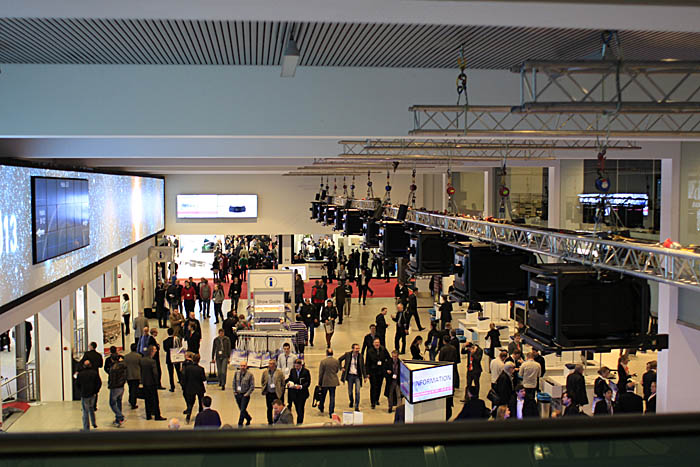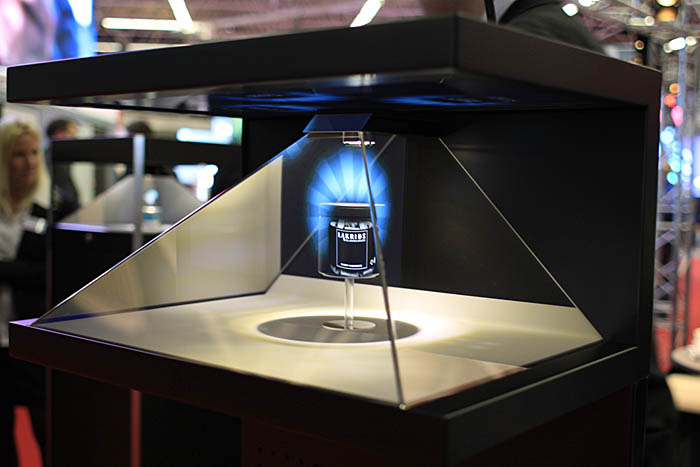Photo report from the exhibition ISE - screens, screens and more screens

Entrance to the exhibition: the connection of 10 projectors on the panoramic screen.

Stand with a 3D image in the air.
A couple of weeks ago, the annual Integrated Systems Europe exhibition was held in Amsterdam . This is the second largest event in the world where audio-visual solutions are shown: screens, projectors, and so on. Manufacturers from around the world are preparing for it and come with new products. The guests of the exhibition are mainly IT specialists of large companies, integrators and their very large customers who need solutions for large projects.
')
This year, at the exhibition, the trend was new technologies in the production of screens: here and LED screens with very small pixel pitch, and laser projectors, and screens of various shapes (triangular, for example). Below is a story about the exhibition itself and brief reviews of the new products presented there.
Careful traffic: on a lot of photos.
Here is another stand with a 3D image, standing next to the one on top:

I'll start with the main thing: below - the flagship of the exhibition, SILICONCORE TECHNOLOGY ORCHID P1.9 with a pixel pitch of 1.9 mm. The screen was introduced by the European integrator LANG. Just a few years ago it was hard to believe that LED technology would come to that.


Most of the exhibition was devoted to solutions in the field of retail sales. Probably the most impressive stands were virtual fitting rooms that are designed for clothing stores. Here they are on the stands of LG and Christie:


LGs are based on LCD panels with LED backlighting, but Christie is based on MicroTiles (small screens that fit seamlessly):


Their interfaces are quite interesting. In the case of LG, the scheme is this: there is a camera above the fitting room. The software of the fitting room determines the presence of a person by the video stream, the distance to it and tries to determine its gender. Then a corresponding collection is offered, which can be controlled by large gestures: he raised his hand - the clothes changed. As can be seen in the photo, the positioning of clothes is not always accurate, but it is already possible to use fitting rooms to simply understand what goes and what doesn't. Christie has two screens: one is touchscreen, clothes are selected on it. After selecting a girl or boy in this dress appears on the second screen.
And here is the video wall at Christie Microtiles. The variant of content for retail is shown:

Last year, many people thought about the correct navigation. This primarily applies to retail stores (where you need to provide data on goods) and public places, such as airports. At this exhibition, each display vendor presented screens of various shapes and orientations for use as signage at train stations, airports, and so on. Here are the new screens of small dimensions for the creation of plates with the description of goods and prices, for example, on the windows in the supermarket (SHELF-VISION):


Here are some mini-screens:

And this is a very interesting decision. Suppose there is a manager who works with clients. Customers sit in front of him, and from time to time he needs to show something on their computer screen. It is not necessary to turn the monitor back and forth, there is a U-SEE2, a stand with two rotating displays. And unlike the usual duplication of information on an additional screen, in this case the content of the two displays may differ: for example, the manager may have slightly more data on the display than the client. In addition, the client display is a touch screen.

Transparent displays have been produced for several years, but it was at this exhibition that particularly beautiful samples were presented. Here is the Samsung version:

And LG. They work like this: the client can get complete information about the product, while seeing the real sample in the window. Or the information may simply be shown continuously, as below in the case of prices. Here, for example, what happens after touching this stand:


Here is another transparent screen:

The exhibition was struck by the abundance of various proposals for kiosks of various forms. Dynascan again brought 360-degree displays and LCD panels with increased brightness of 1500 Lm. Round View Screen:

I liked the stand of Unitech systems with moving TV anchorages and wall cases with a sliding shutter:

In terms of Digital Signage systems and content broadcasting, decisions from C-nario (YCD Multimedia) and Scala remain relevant:


Scala also has mini-displays in its portfolio, for example, for reservation of meeting rooms (iAdea). More such solutions are in Spinetix and Brightsign.
We have already “approached” the Samsung stand several times, but have not yet seen it from the side. And there is something to look at, because it was the largest in area at the exhibition and offered an abundance of technical solutions. First of all, there were, of course, design solutions for retail (panels for shop windows in different configurations), integration of Magicinfo with Scala, a line of hotel TVs, transparent displays, video walls and so on. That was how wonderful the stand looked:



Samsung’s booth also showed the largest LED panel in the world! Available at the end of the year:

Video wall of 55 inch Samsung panels with a frame of 5.5 mm:

LG introduced a huge 3D video wall. This is a wonderful thing for event business, exhibitions and museum installations:

Artur Holm made the generation of monitors Dynamic 3: very high quality, now I advise them and only them!



Go ahead. Here are the LCD touch panels:

And this is already familiar to us multitouch table:

At the Mitsubishi booth, video integration with the bike was shown. All actions are displayed on the screen (steering, speed, etc.). A simple game: you need to get from point A to point B, while on the way there are obstacles in the form of cars, pedestrians, and so on. Pleasant exercise bike.

Scala software integration with Samsung embedded PCs.

Sony booth:

Without such a screen, the description of the exhibition simply could not be complete:

Receiver-video transmitter via optical cable:

The stand of the company NEC. Retail content is shown again:

Cubes Christie Microtiles. Another use case is shown:

Rear projection screen on Christie booth:

Mortise monitor with congress system:

Audio mixer for concerts.

Touch table is designed as an iPad.

Interactive kiosk.

Touch Kiosks / Stands:


Options for the performance of LED grids.



The use of LED screens.

And finally - a panorama of the exhibition from the entrance area (and again you can see the screen, which employs 10 projectors from the picture to kata):

In general, it is too early to draw conclusions about the demand for all the solutions presented - let's see which market niche will be occupied by transparent display cases and laser projectors. After a couple of years, we are waiting for the breakthrough of OLED technologies in the field of display systems.
Source: https://habr.com/ru/post/169863/
All Articles